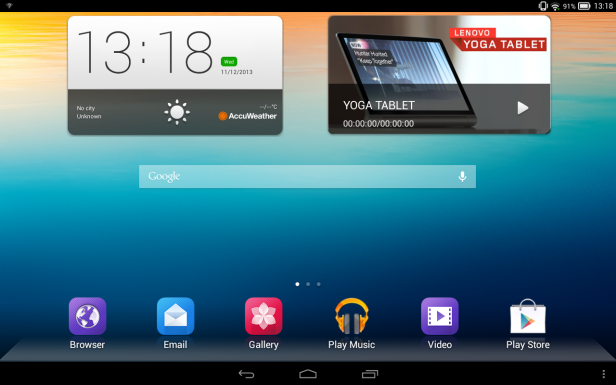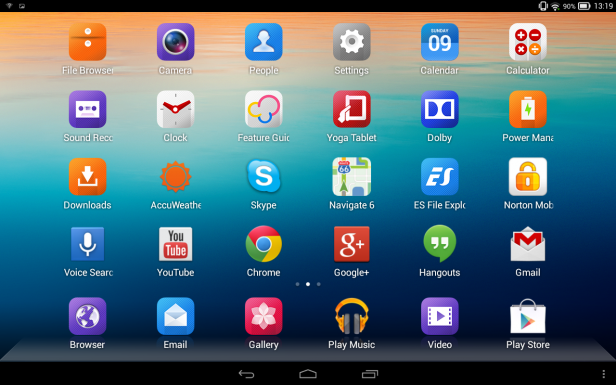Lenovo Yoga Tablet 10 Review - Software and Performance Review
Software and Performance
The Yoga Tablet 10 has the best battery life of any tablet around

Sections
- Page 1 Lenovo Yoga Tablet 10 Review
- Page 2 Software and Performance Review
- Page 3 Camera and Battery Life Review
- Page 4 Keyboard Cover and Verdict Review
Lenovo Yoga Tablet 10 – Software
The Yoga Tablet 10 runs Android 4.2 Jellybean, which means it comes it comes with features like Google Now, and the ability to create folders and so on. It runs smoothly, and Lenovo hasn’t made much attempt to reskin Android, although it has taken away the app drawer, so everything sits on the homescreens. This means it can get a bit crowded if you don’t take advantage of Jellybean’s folder creation.
It’s mercifully free of custom software and bloatware. Aside from a Lenovo promotional video on the desktop showing you the tablet’s functions via a series of lifestyle shots, the front homepage is filled with six Google staples: ‘Browser’, ‘Email’, Gallery’, ‘Play Music’, ‘Video’ and ‘Play Store’.

The few pieces of non-Google software that are installed by default are versions of software that you would generally find useful anyway. There’s Kingsoft Office, which allows you to open various documents without fuss; ‘txtr Lenovo Edition which is a simple ebook reader; ES File Explorer which does the dull but necessary job of file management as well as anything else; and finally there’s Accuweather and Skype, which plenty of people will end up downloading anyway. The only piece of software we treated with suspicion is Norton Mobile Security, and tapping that presents the option to download and install it, so it’s more an advert than an actual app.

The lack of bespoke software could be a complaint, but honestly we’ve seen so many tablets and phones arrive filled up with applications we don’t want that this straight Jellybean approach is very welcome. The Android O/S is pretty sophisticated nowadays and even in this semi-vanilla form there’s not a great deal that we miss — certainly not enough to have it pre-installed for us.
Lenovo Yoga Tablet 10 – Performance
Despite its lowish tablet specifications (just 1GB RAM and a 1.2GHZ processor), the performance of the Yoga Tablet 10 is perfectly acceptable in its day-to-day usage. Swapping between homescreens is fast and responsive, and even with several tabs open the tablet doesn’t break too much of a sweat. We put this down to the largely plain installation of Android, unsaddled with the bloatware of some of its rivals.
When it comes down to our tablet tests, things get a little clearer. In Geekbench 3, the Yoga Tablet scored a low 1,086. That’s a little worse than decent smartphones like 2012’s iPhone 5 (1,168) and this year’s bargain Motorola Moto G (1,155), and significantly behind recent tablets like the iPad Air (2,690), Galaxy Note 10.1 (2,756) and the Nexus 7 (2,523). Even the budget Tesco Hudl tablet beats it, with a score of 1,360.

Next, we put its 3D graphics through itspaces using 3DMark, and it managed a score of just 2,525. This is really low, behind the aging iPad 2 (2,690) and significantly behind top-end tablets like the iPad Air (14,742), Surface 2 (13,557) and Note 10.1 (14,276).
That said, in the real world its gaming performance is reasonable, and the pretty intensive Real Racing 3 runs at a playable framerate, albeit clearly not at its prettiest. You should still be able to do some gaming on the system, but it’s not the best performer out there.
How we test tablets
We test every tablet we review thoroughly. We use industry standard tests to compare features properly and we use the tablet as our main device over the review period. We’ll always tell you what we find and we never, ever, accept money to review a product.


